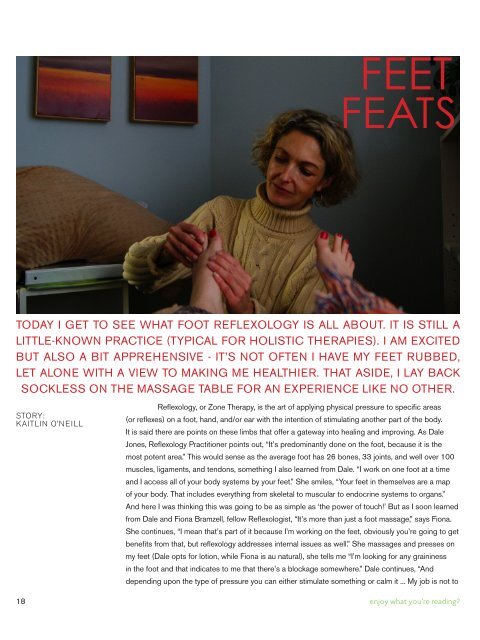PDF file - Local Magazine
PDF file - Local Magazine
PDF file - Local Magazine
You also want an ePaper? Increase the reach of your titles
YUMPU automatically turns print PDFs into web optimized ePapers that Google loves.
TODAY I GET TO SEE WHAT FOOT REFLEXOLOGY IS ALL ABOUT. IT IS STILL A<br />
LITTLE-KNOWN PRACTICE (TYPICAL FOR HOLISTIC THERAPIES). I AM EXCITED<br />
BUT ALSO A BIT APPREHENSIVE - IT’S NOT OFTEN I HAVE MY FEET RUBBED,<br />
LET ALONE WITH A VIEW TO MAKING ME HEALTHIER. THAT ASIDE, I LAY BACK<br />
SOCKLESS ON THE MASSAGE TABLE FOR AN EXPERIENCE LIKE NO OTHER.<br />
STORY:<br />
KAITLIN O’NEILL<br />
18<br />
FEET<br />
FEATS<br />
Reflexology, or Zone Therapy, is the art of applying physical pressure to specific areas<br />
(or reflexes) on a foot, hand, and/or ear with the intention of stimulating another part of the body.<br />
It is said there are points on these limbs that offer a gateway into healing and improving. As Dale<br />
Jones, Reflexology Practitioner points out, “It’s predominantly done on the foot, because it is the<br />
most potent area.” This would sense as the average foot has 26 bones, 33 joints, and well over 100<br />
muscles, ligaments, and tendons, something I also learned from Dale. “I work on one foot at a time<br />
and I access all of your body systems by your feet.” She smiles, “Your feet in themselves are a map<br />
of your body. That includes everything from skeletal to muscular to endocrine systems to organs.”<br />
And here I was thinking this was going to be as simple as ‘the power of touch!’ But as I soon learned<br />
from Dale and Fiona Bramzell, fellow Reflexologist, “It’s more than just a foot massage,” says Fiona.<br />
She continues, “I mean that’s part of it because I’m working on the feet, obviously you’re going to get<br />
benefits from that, but reflexology addresses internal issues as well.” She massages and presses on<br />
my feet (Dale opts for lotion, while Fiona is au natural), she tells me “I’m looking for any graininess<br />
in the foot and that indicates to me that there’s a blockage somewhere.” Dale continues, “And<br />
depending upon the type of pressure you can either stimulate something or calm it ... My job is not to<br />
enjoy what you’re reading?
diagnose, but is to clear up any energy blockages or congestion<br />
in your body.” Fiona adds, “That’s really important to make people<br />
aware of that! I mean, we’re not doctors. [Reflexology] can be<br />
very successful in treating certain disorders... but it’s certainly not<br />
a replacement if you need medical treatment.”<br />
The theories and practice of modern Reflexology have<br />
been around for centuries. Ancient Egyptian walls are etched<br />
with practitioners giving hand and foot massages, while Chinese<br />
medical text Huangdi Neijing (475-221 BC) contains a section<br />
titled Examining Foot Method. Also similar is acupuncture and its<br />
fundamentals regarding proper energy and blood flow. However,<br />
the exact point at which Reflexology was developed is still<br />
uncertain; many cultures and medical professionals have had a<br />
hand in shaping the alternative therapy.<br />
It is said that in 1582 Europe, Dr. Adamus and<br />
Dr. A’tatis published the first book on Zone Therapy. Shortly<br />
thereafter a second book was released by Dr. Bell in Leipzig,<br />
Germany. Although Zone Therapy is essentially Reflexology,<br />
it wasn’t until Russian Drs. Pavlov and Bekhterev’s study of<br />
human reflexes that the practice became known by the name.<br />
A couple of decades later Dr. William H. Fitzgerald, returning<br />
from Vienna in early 1900’s with new knowledge, introduced the<br />
United States to this new Reflex Therapy. Fitzgerald continued to<br />
make new discoveries and links between pressures points and<br />
pain relief. Dr. Shelby Riley worked closely with Fitzgerald and<br />
helped shape his theories further. It was Riley’s influence that<br />
catapulted Physiotherapist Eunice D. Ingham into the creation of<br />
what is now known today as a Reflexology chart. By combining<br />
previous reflex knowledge with the concept of invisible lines, or<br />
meridians, this map illustrated sections of the foot connecting to<br />
corresponding parts of the body. This is how Reflexologists are<br />
able to curb pain and energy blockage to the body from the feet.<br />
The benefits are wide, especially if your practitioner<br />
knows your feet. Both Dale and Fiona tell me they’ve treated<br />
ailments such as digestive issues, sinus problems, and arthritis<br />
to name just a few. Dale helps explain further, “I’m improving<br />
circulation, I’m sending nerve impulses throughout your body,<br />
and it’s going to reduce inflammation, it washes toxins out of<br />
your body, [and] it gets rid of lactic acid that sits around your<br />
muscles.” All the while you are free to relax and focus on your<br />
well-being, a very meditative experience.<br />
Once my treatment is complete and the ambient music<br />
fades out, I feel asleep but awake. It was an experience so Zen,<br />
organic, and peaceful. I’m not as apprehensive as I was when I<br />
walked into the room, in fact all my attention was focused inward.<br />
Even if you are sceptical, a stress-melting, hour-long escape is<br />
not something easily argued with, as deadly as we know stress<br />
to be. I also have to admit, as surreal as it was, that my feet gave<br />
away my secret - I have stiff, sore hips at times. Take my advice<br />
and do yourself a favour because, as the Dalai Lama says, “If the<br />
mind is tranquil and occupied with positive thoughts, the body<br />
will not fall prey to disease.”<br />
to find local businesses, visit www.localmagazine.ca 19


